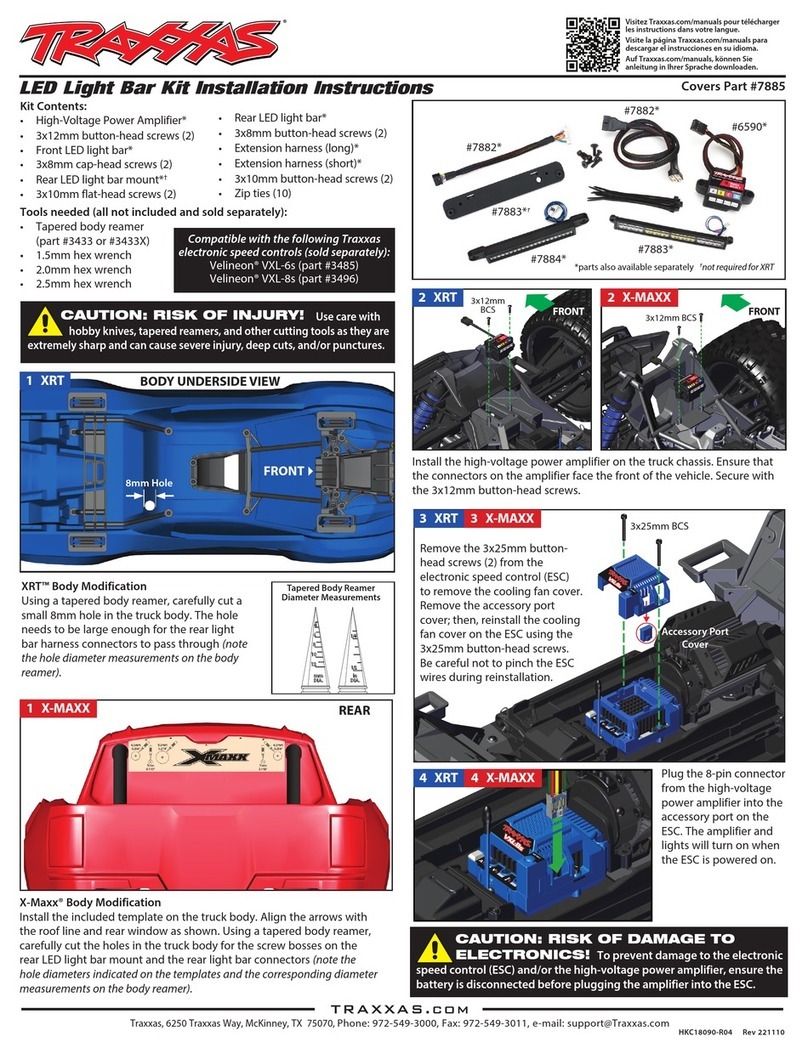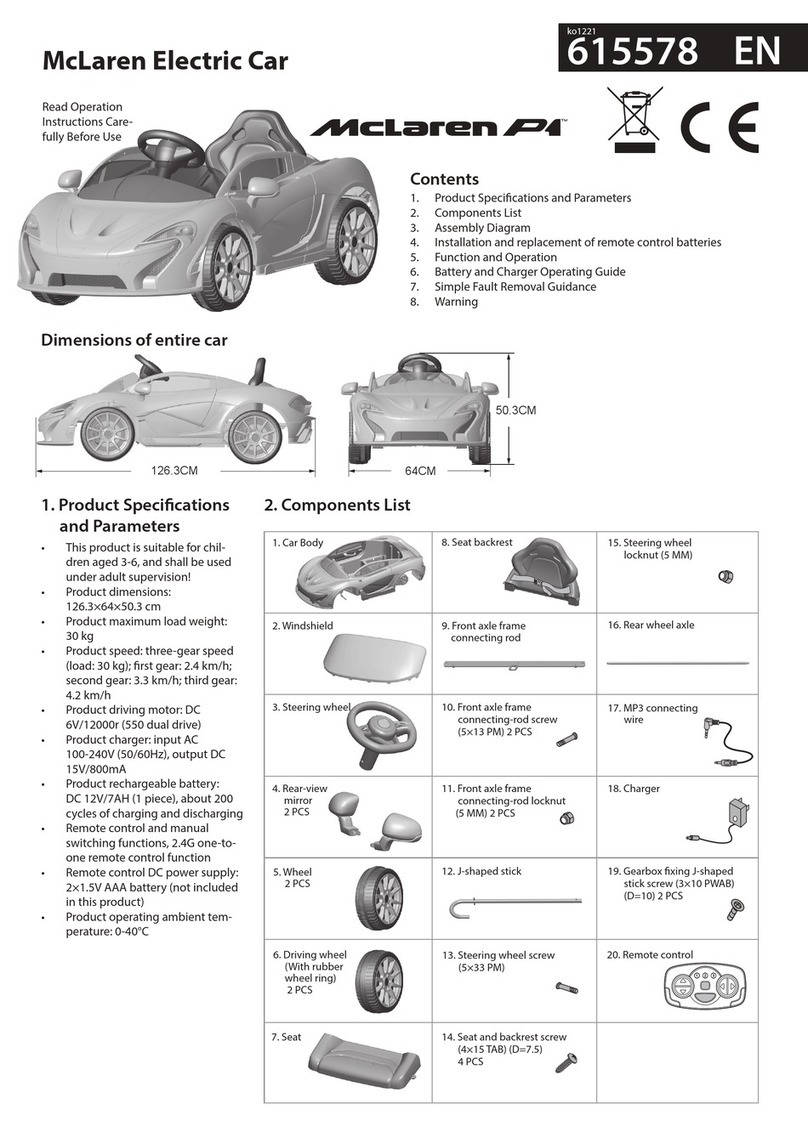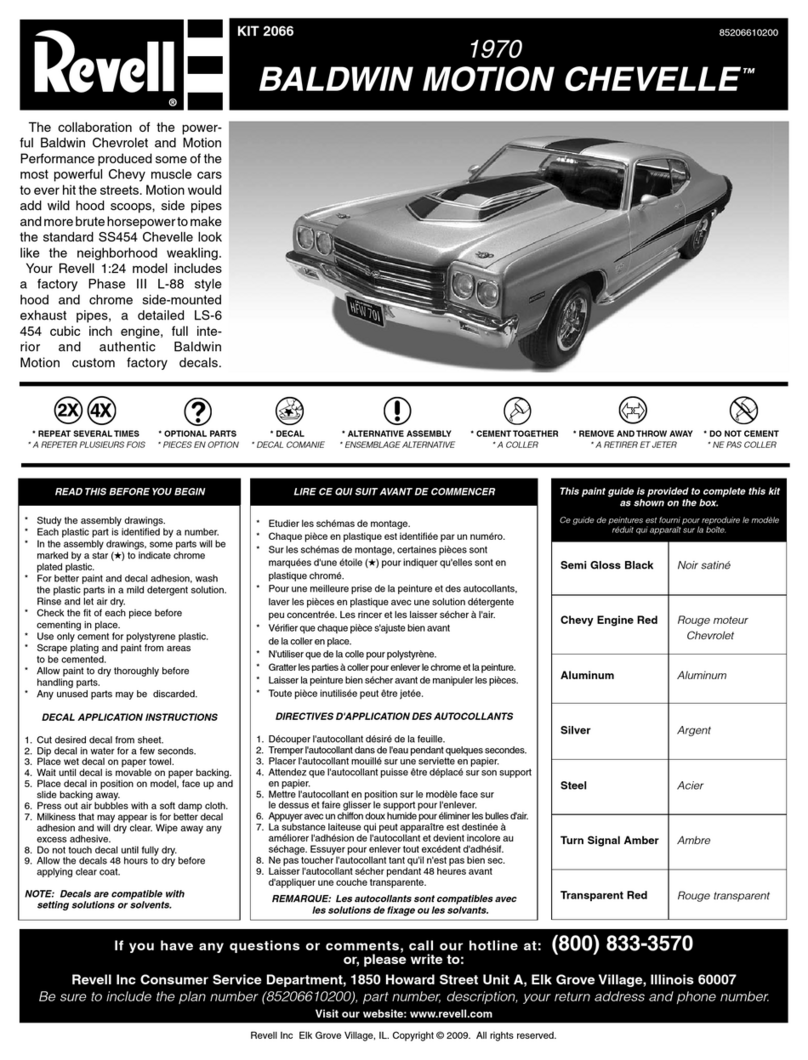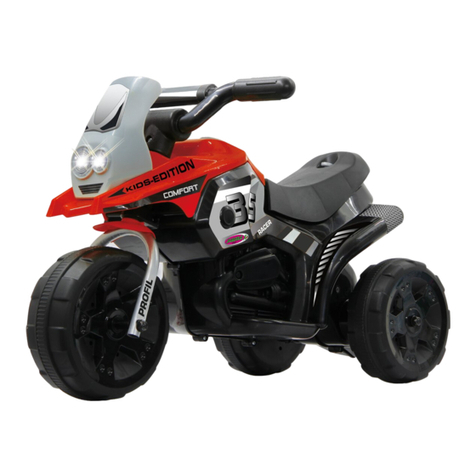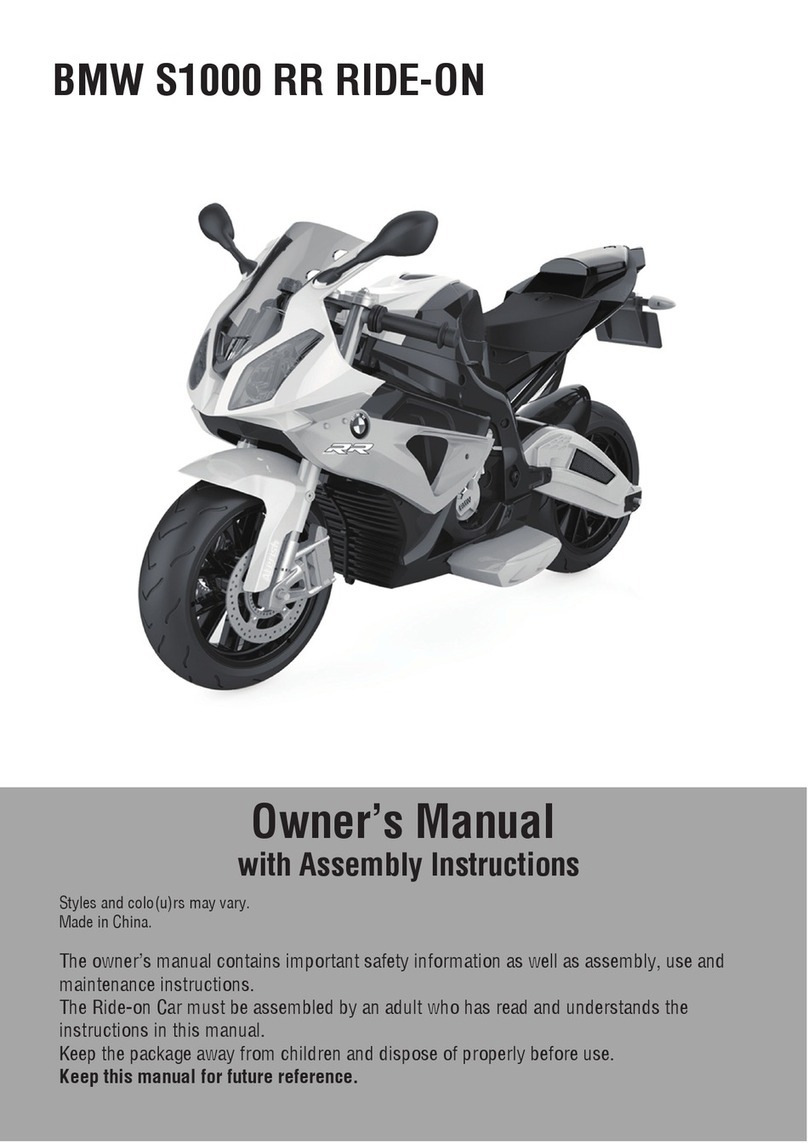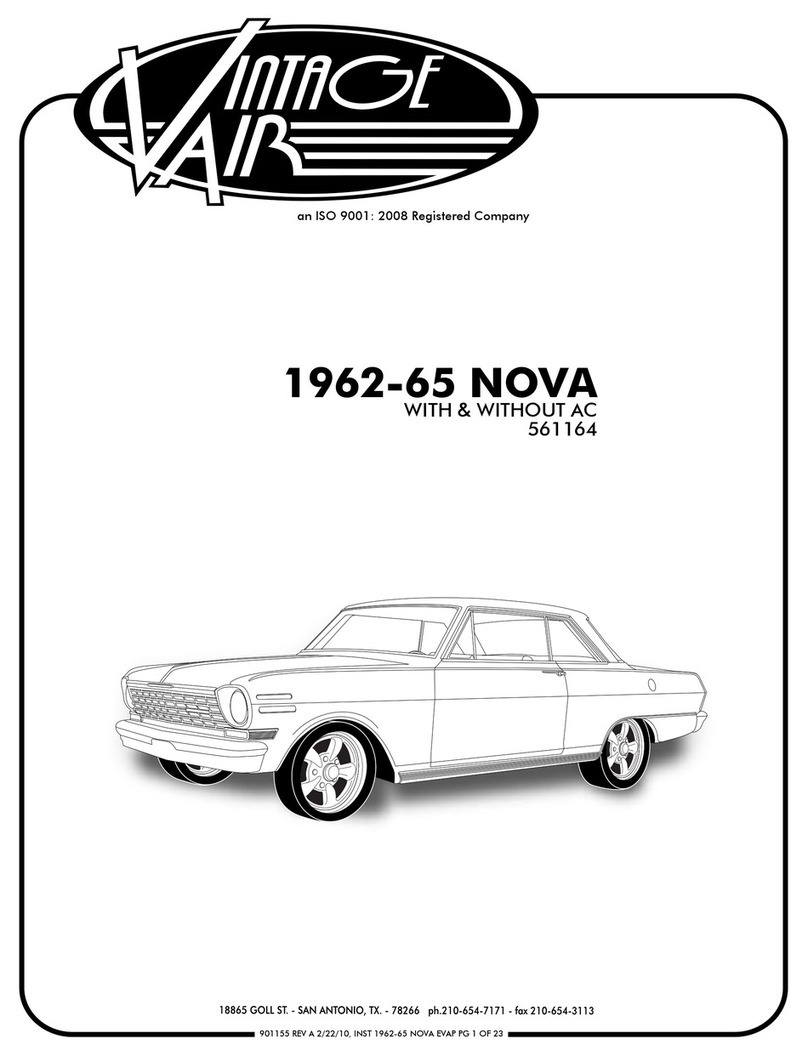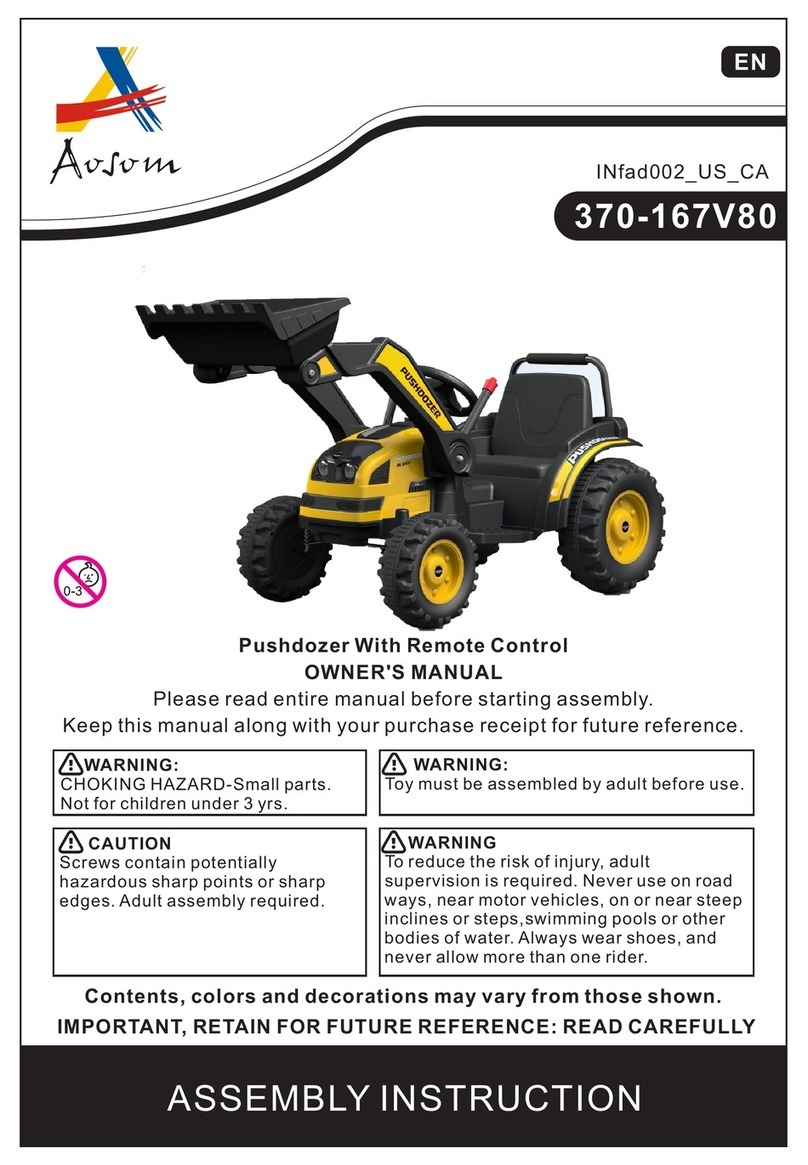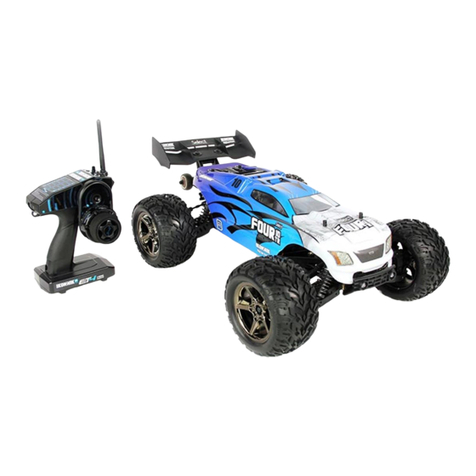Roc Hobby 1:12 TYPE82 KUBELWAGEN User manual

Length: 317mm
Width: 135mm Height:129mm
Wheel base: 202mm Ground clearance: 28mm
Approach angle: 40° Departure angle: 60°
SPECIFICATION
Manuel d’utilisation
Instruction Manual
Bedienungsanleitung
操作手册
1:12 type82
kubelwagen


TABLE OF CONTENTS
EN
2
SAFETY PRECAUTIONS
RADIO SYSTEM
PRODUCT INTRODUCTION
THROTTLE STICK POSITION
VEHICLE SETUP
OPERATING THE VEHICLE
TRANSMISSION
CAR SHELL
CHASSIS
REAR WHEEL
RIGHT-FRONT WHEEL
ACCESSORIES LIST
...........................................................................................................................
.........................................................................................................................................
..................................................................................................................
..................................................................................................................
.........................................................................................................................................
.....................................................................................................................
.......................................................................................................................................
..................................................................................................................................................
......................................................................................................................................................
...............................................................................................................................................
............................................................................................................................
...................................................................................................................................
03
05
06
18
18
19
37
39
41
43
43
45

• Replace damaged components with original factory-parts. Pay special attention to the polarity
of all vehicle wiring.
• Use common sense when selecting the environment to operate your vehicle. Do not operate
near power cables, cellular/radio towers, deep water or unstable terrain. The operator is solely
responsible for their actions.
• The product is composed of precision electrical components. It is critical to keep the product
away from moisture and other contaminants.
• Always check the radio range of the vehicle prior to operation in order to prevent radio loss or
interference.
• Operate this product within your ability. If the vehicle is dangerous to retrieve, it never worth the
risk.
• Always turn on the transmitter before connecting the battery on the model. When turning off the
model, always disconnect the battery first, and then turn off the model, always disconnect the
battery first, and then turn off the transmitter. If this order is reversed, the model may become
uncontrollable and cause serious damage.
• Never allow transmitter batteries to run low as it may cause loss of vehicle control.
• Plastics on the vehicle are susceptible to damage or deformation due to extreme heat and cold
climate. Do not store the model near any source of heat such as oven or heater. Store the model
indoors, in a climate-controlled, room temperature environment.
Introduction
Safety, precautions and warnings
SAFETY PRECAUTIONS
The associated regulatory agencies of the following countries recognize the noted certifications
for this product as authorized for sale and use.
CE compliance information for the european union
EN
Declaration of Conformity
Products: 2.4GHz Controller
Equipment Class: 2
The objects of declaration described above are in
conformity with the requirements of the
listed below.
Item Name : 2.4GHz Controller
The RED Directive 2014/53/EU
EN 60950-1:2006 + A11:2009 + A1:2010
+ A12:2011 + A2:2013
EN 300 328 V2.1.1:2016
EN 301 489-1 V2.1.1:2017
EN 301 489-17 V3.1.1:2017
UK DE DK BG SE GZ ES NL SK HU RO FR PT
FI EE LV LT PL AT CY SI GR MT IT IE LU
3
This manual is written to assist you in properly operating, maintaining and repairing the vehicle.
As many of the components used are unique to this truck, please retain this manual as a future
reference.
Composed of precision-made components, the Rochobby 1:12 Suzuki Jimny is not a toy, thus it
is not suited for children under 14 years of age. Minors should be accompanied by an adult when
operating. Failure to operate or maintain this vehicle in a safe manner can result in bodily harm.
It is the owner responsibility to operate this product in a safe manner. Rochobby and its distribu-
tors are not responsible in any way for any and all bodily harm and/ or property damage that may
result from the use of this product. Replace damaged components with original factory-parts.
Pay special attention to the polarity of all vehicle wiring.

EN
RF Exposure Compliance
This equipment complies with FCC radiation exposurelimits set forth for an uncontrolledenvironment. This
equipment should be installed and operated with minimum distance 20cm between the radiator and your body.
This transmitter must not be co-located or operating in conjunction with any other antenna or transmitter.
Environmentally friendly disposal
Old electrical appliances must not be disposed of together with the residual waste, but have to be disposed of
separately. The disposal at the communal collecting point via private persons is for free. The owner of old appli-
ances is responsible to bring the appliances to these collecting points or to similar collection points. With this
little personal effort, you contribute to recycle valuable raw materials and the treatment of toxic substances.
Certification
FCC Compliance Statement
This device complies with Part 15 of the FCC Rules. Operation is subject to the following two conditions:
(1) this device may not cause harmful interference, and (2) this device must accept any interference received,
including interference that may cause undesired operation.
Warning: changes or modifications not expressly approved by the party responsible for compliance could void
the user's authority to operate the equipment.
This equipment has been tested and found to comply with the limits for a Class B digital device, pursuant to
Part 15 of the FCC Rules. These limits are designed to provide reasonable protection against harmful interfer-
ence in a residential installation. This equipment generates, uses and can radiate radio frequencyenergy and,
if not installed and used in accordance with the instructions, may cause harmful interference to radio communi-
cations. However, there is no guarantee that interference will not occur in a particular installation.
If this equipment does cause harmful interference to radio or television reception, which can be determined by
turning the equipment off and on, the user is encouraged to try to correct the interference by one or more of the
following measures:
1.Reorient or relocate the receiving antenna.
2.Increase the separation between the equipment and receiver.
3.Connect the equipment into an outlet on a circuit different from that to which the receiver is connected.
4.Consult the dealer or an experienced radio/TV technician for help.
FCC ID: N4ZR4A10
4
This product is not a toy! (14+) Recommended for ages 14 and up. Adult supervision
required for ages under 14 years old. Contains small parts, keep out of reach of children
3 years of age and younger.
Please read this manual carefully prior to using.We are not responsible for any intention-
al damage or improper use. lf you require any additional information or have any
quesions adout he product or its use,please contact us via.
MADE IN CHINA

Safety symbols
Safety guide
RADIO SYSTEM
EN
Pay close attention to the following symbols and their meanings. Failure to follow these warnings could
cause damage,injury or death.
Danger Not following these instructions may lead to serious injuries or death.
Warning Not following these instructions may lead to major injuries.
Attention Not following these instructions may lead to minor injuries.
Prohibited Mandatory
Do not use the product at night or in bad weather like rain or thunderstorm. It can cause
erratic operation or loss of control.
Do not use the product when visibility is limited.
Do not use the product on rain or snow days. Any exposure to moisture (water or snow)
may cause erratic operation or loss of control.
Interference may cause loss of control. To ensure the safety of you and others, do not
operate in the following places:
Do not use this product when you are tired, uncomfortable, or under the influence of
alcohol or drugs. Doing so may cause serious injury to yourself or others.
The 2.4GHz radio band is limited to line of sight. Always keep your model in sight as a
large object can block the RF signal and lead to loss of control.
Do not touch any part of the model that may generate heat during operation, or imme-
diately after use. The engine, motor or speed control, may be very hot and can ause se-
rious burns.
Misuse of this product may lead to serious injury or death. To ensure the safety of you
and your equipment, read this manual and follow the instructions.
Make sure the product is properly installed in your model. Failure to do so may result
in serious injury.
Make sure to disconnect the receiver battery before turning off the transmitter. Failure
to do so may lead to unintended operation and cause an accident.
Ensure that all motors operate in the correct direction. If not, adjust the direction first.
Make sure the model stays within the systems maximum range to prevent loss of control.
5

PRODUCT INTRODUCTION
EN
6
In the 1930s,German constructed the KdF Motor City in Wolfsburg, Lower Saxony, and registered
the Gesellschaft zur Vorbereitung des Deutschen Volkswagens mbH, which later developed into
the world-renowned Volkswagen headquarters and where the national car KdF-Wagen was
produced.
KdF-Wagen, known as the people's car while none of which was sold to the people with all being
requisitioned and converted into military vehicles, the most famous one of which is Kübelwagen.
The Kübelwagen, which literally means "bucket car" and refers specifically to a light military
open-top off-road vehicle, was developed in January 1938, featuring a low body and low
weight,being easy to manufacture in large numbers, and cost-effective.
The prototype was developed on the basis of the People's Car KdF-Wagen chassis, model Typ62,
with an air-cooled horizontally opposed four-cylinder engine and a rear-mounted rear-wheel drive
layout. Although only rear-wheel drive was available, a limited-slip differential from ZF was used,
greatly enhancing the ability to get out of trouble. The talented designer Dr. Ferdinand Porsche
then continued to improve on this basis, adding wheel-side reducers to build a portal rear axle, and
increasing the ground clearance of the chassis by 50mm to a staggering 310mm. In December
1939, two Typ82s rolled off the assembly line,underwent and successfully passed rigorous tests
in Kummersdorf and Eisenach, and received its official name Pkw.K1 Typ82. It later became the
most widely used and best-performing light off-road vehicle in the German army, and was loved
by front line and soldiers. In late 1942, the U.S. Army acquired a Type 82 Kubelwagen, which was
then tested at Aberdeen Proving Ground. Army automotive experts evaluated it as an excellent
driving performance and good handling car with four-wheel independent suspension and an LSD
limited slip differential on the rear axle, with off-road performance approaching that of a four-wheel
drive vehicle. The actual test concluded that the bucket car was not as good as the Willys in terms
of extrication in extreme terrain, but in most off-road conditions the Typ82 showed excellent driving
performance as Willys, and better on-road driving performance and comfort than the Willys.In
addition, the barrel weighs only 685kg and the 985cc engine can produce 23.5hp with half the fuel
consumption of the Willys. In other words, the Germans used 60% of the raw materials to obtain
tactical maneuverability close to that of the Americans. With no beams, a smooth chassis,
extremely low unit pressure after installing desert tires, and an air-cooled engine that required
even less water, the barrel car's off-road performance in the desert terrain of the North African
battlefield far exceeded that of a 4WD. Later in the war the Germans were losing, and the U.S.
Army had the opportunity to capture more intact Type82, and the barrel car's good performance
was so popular with the U.S. Army that soldiers were even willing to trade two Willys for one
Type82.
Type82 is rear-wheel drive, while Typ86 and Typ87 four-wheel drive, of which Typ86 is not
mass-produced as the off-road performance of the Typ82 has been so excellent that increased
performance four-wheel drive version brought was more than pay for itself considering the
strained strategic resources. Moreover,its complex structure is also not conducive to wartime
production on a large scale, not to mention the maintenance burden brought to the logistics units.
Therefore, the four-wheel drive structure was only used on the Typ87 and the amphibious
Typ128/166, which had to use four-wheel drive.
Research Background
Construction Features

EN
7
The FMS 1/12 Kübelwagen RC Model presents itself in Mid-term to take you back to the war-torn
era with its spectacular design.
We start with engine.The Boxer air-cooled engine serves as the core of the car, an engine used in
several later generations of classic cars and lasted 65 years in the Beetle, a saga that came to an
end when the last Beetle, number 21,529,464, rolled off the production line in Puebla, Mexico, on
July 30, 2003.
Initially the Typ82 used a 985cc engine, later upgraded to 1131cc, then gradually increased
displacement, and in the PPPPPPPPPP used a 1488cc engine, doubling the horsepower from the
very beginning. The cylinders of the horizontally opposed engine are distributed on both sides, a
130 motor in the right cylinder position, and another 130 motor reserved for the left side, which can
output twice as much power when applied to the PPPPP or PPPPPPPPPP platform. The engine
crankshaft flywheel is connected by a belt to drive the generator and the cooling fan as well. The
semi-circular fan fairing is a major feature, in which the airflow is distributed to the cylinders on
both sides. All is restored on the model, meaning you can observe the blades rotating through the
fan intake when the motor is running. The Kübelwagen has 4 forward gears and the maximum
speed of each gear respectively goes as 1st gear 18.4km/h; 2nd gear 32.4km/h; 3rd gear
54.2km/h; 4th gear 83.6km/h. The corresponding red line of gearshift tips is available on the
dashboard. On the model, we designed a 2-speed shift to simulate the speed of the 1st and 3rd
gears of the real car. The power crosses over from the top of the rear axle differential and then
returns to the rear axle. The model share the same structure as the real engine, with the benefit of
compactness, making it easy to switch between 4WD and RWD modes. This shift function is
perfectly reproduced on the model to provide more driving pleasure when driving off-road.
Then let’s move to chassis. The popular portal axle in today's crawler market has been in mass
production for barrel car as early as 82 years ago, from which wheelside reducer reduction ratio of
15:21 has learned a lot, making the barrel car chassis minimum ground clearance of 310mm,
dwarfing all modern off-road cars on the market today. On the real car, the front and rear wheel
speeds are balanced by increasing the front axle differential gear ratio while on the model we set
the door axle reduction ratio to 1:1 for common front and rear axle differentials.
Solid load-bearing chassis with stamped central ridge tube chassis and body bears high torsional
resistance. The central drive shaft and electrical wiring are hidden in the ridge tube. The one piece
injection model features the texture of metal stamping with plastic as location and size of each
reinforcement are restored according to the actual car. The front and rear wheels adopt
torsion-bar-springs independent suspension allowing long travel capability and little space
occupation. We use torsion springs instead of torsion bar springs to present the front and rear
suspension, Easy to disassemble and change tuning.
The car body, on which R&D team spend the most time where you can see the BBBBB horn and
headlights, NNNNN camouflage lights. The tires are the most common 5.25×16 in the barrel car.
The prototype was developed on the basis of the People's Car KdF-Wagen chassis, model Typ62,
with an air-cooled horizontally opposed four-cylinder engine and a rear-mounted rear-wheel drive
layout. Although only rear-wheel drive was available, a limited-slip differential from ZF was used,
greatly enhancing the ability to get out of trouble. The talented designer Dr. Ferdinand Porsche
then continued to improve on this basis, adding wheel-side reducers to build a portal rear axle, and
increasing the ground clearance of the chassis by 50mm to a staggering 310mm. In December
1939, two Typ82s rolled off the assembly line,underwent and successfully passed rigorous tests
in Kummersdorf and Eisenach, and received its official name Pkw.K1 Typ82. It later became the
most widely used and best-performing light off-road vehicle in the German army, and was loved
by front line and soldiers. In late 1942, the U.S. Army acquired a Type 82 Kubelwagen, which was
then tested at Aberdeen Proving Ground. Army automotive experts evaluated it as an excellent
driving performance and good handling car with four-wheel independent suspension and an LSD
limited slip differential on the rear axle, with off-road performance approaching that of a four-wheel
drive vehicle. The actual test concluded that the bucket car was not as good as the Willys in terms
of extrication in extreme terrain, but in most off-road conditions the Typ82 showed excellent driving
performance as Willys, and better on-road driving performance and comfort than the Willys.In
addition, the barrel weighs only 685kg and the 985cc engine can produce 23.5hp with half the fuel
consumption of the Willys. In other words, the Germans used 60% of the raw materials to obtain
tactical maneuverability close to that of the Americans. With no beams, a smooth chassis,
extremely low unit pressure after installing desert tires, and an air-cooled engine that required
even less water, the barrel car's off-road performance in the desert terrain of the North African
battlefield far exceeded that of a 4WD. Later in the war the Germans were losing, and the U.S.
Army had the opportunity to capture more intact Type82, and the barrel car's good performance
was so popular with the U.S. Army that soldiers were even willing to trade two Willys for one
Type82.
Type82 is rear-wheel drive, while Typ86 and Typ87 four-wheel drive, of which Typ86 is not
mass-produced as the off-road performance of the Typ82 has been so excellent that increased
performance four-wheel drive version brought was more than pay for itself considering the
strained strategic resources. Moreover,its complex structure is also not conducive to wartime
production on a large scale, not to mention the maintenance burden brought to the logistics units.
Therefore, the four-wheel drive structure was only used on the Typ87 and the amphibious
Typ128/166, which had to use four-wheel drive.
Like the real car, the simulated wheels need to be fixed with 5 screws, the spare tire on the front
available for being taken off and installed for use. Remove the spare tire, the typical of the mid-cy-
cle spare tire bracket is readily accessible. The windshield can be put down and fixed on the front
bracket and the real rearview mirror’s angle is adjustable like a real car.
The openable four doors are not worth mentioning but it would be much more interesting to find
the structure that the doors could be opened and locked by turning the door handle. The comfort-
able seats have soft foam cushions even a little bit luxurious by 1939 standards.
The dashboard shows the speed and timing of gear changes with the current mileage 203 km,
about the distance driven from the Wolfsburg factory to Berlin. No doubt we are selling a new car.
To start this car, it is hard to find the switch but the user guide of the real car is available for you to
find the start button in the lower left corner of the dashboard. Just press it through the steering
wheel.A sweet gadget is also provided for your convenience. As FMS always did, the steering
wheel and the wheel are linked. With 1/12 figures, a plot can be vividly displayed and users can
gradually refine the plot with the increase of this series.
The armrest in front of the rear seats has four clips in the middle that fit into holes in the floor to
hold four 98K rifles which were produced by the Mauser Arsenal in Oberndorf and needed to be
purchased separately for 70 Reichsmark each at the 1939 exchange rate. The rear seatbacks
could be lowered for easy access to supplies from the trunk. Great efforts have been made on
optimizing the layout of the electronics to prevent the battery or receiver from taking up space in
the trunk. The trunk height of the Typ82 was designed to accommodate 20L oil (water) Jerry can
or to store weapons, ammunition, and food supplies. All these features are properly restored to
make the user experience more fun, but of course, these supplies, like the 98K, had to be
purchased separately.
For the electronic system, 4-channel digital proportional remote control system is applied. In
addition to 1&2 channels for steering and throttle control, the 3rd channel controls the gearshift
and the 4th channel switching between 4WD and RWD. There is also integrated light control,
which allows you to turn on the headlights during normal night driving. Linked turn signals and
brake lights are at the rear of the car. Users can only turn on the anti-aircraft lights during the night
light restriction.
Then comes to the packaging, which used environmental friendly foam material to simulate the
World War II German tin ammunition boxes. The recyclable box can bear long-distance transport
easy to store, easy to carry.
Kübelwagen has a far-reaching impact on automobile history. Many famous hobby brands have
repeatedly launched related products. So far, no one can do as well as us.
We here at FMS hope you enjoy the Kübelwagen Type 82 as much as we did in bringing it to life
in the form of this classic piece of wartime history.
Ty82 Research Team
2021.9.29
About Mode

EN
8
The FMS 1/12 Kübelwagen RC Model presents itself in Mid-term to take you back to the war-torn
era with its spectacular design.
We start with engine.The Boxer air-cooled engine serves as the core of the car, an engine used in
several later generations of classic cars and lasted 65 years in the Beetle, a saga that came to an
end when the last Beetle, number 21,529,464, rolled off the production line in Puebla, Mexico, on
July 30, 2003.
Initially the Typ82 used a 985cc engine, later upgraded to 1131cc, then gradually increased
displacement, and in the PPPPPPPPPP used a 1488cc engine, doubling the horsepower from the
very beginning. The cylinders of the horizontally opposed engine are distributed on both sides, a
130 motor in the right cylinder position, and another 130 motor reserved for the left side, which can
output twice as much power when applied to the PPPPP or PPPPPPPPPP platform. The engine
crankshaft flywheel is connected by a belt to drive the generator and the cooling fan as well. The
semi-circular fan fairing is a major feature, in which the airflow is distributed to the cylinders on
both sides. All is restored on the model, meaning you can observe the blades rotating through the
fan intake when the motor is running. The Kübelwagen has 4 forward gears and the maximum
speed of each gear respectively goes as 1st gear 18.4km/h; 2nd gear 32.4km/h; 3rd gear
54.2km/h; 4th gear 83.6km/h. The corresponding red line of gearshift tips is available on the
dashboard. On the model, we designed a 2-speed shift to simulate the speed of the 1st and 3rd
gears of the real car. The power crosses over from the top of the rear axle differential and then
returns to the rear axle. The model share the same structure as the real engine, with the benefit of
compactness, making it easy to switch between 4WD and RWD modes. This shift function is
perfectly reproduced on the model to provide more driving pleasure when driving off-road.
Then let’s move to chassis. The popular portal axle in today's crawler market has been in mass
production for barrel car as early as 82 years ago, from which wheelside reducer reduction ratio of
15:21 has learned a lot, making the barrel car chassis minimum ground clearance of 310mm,
dwarfing all modern off-road cars on the market today. On the real car, the front and rear wheel
speeds are balanced by increasing the front axle differential gear ratio while on the model we set
the door axle reduction ratio to 1:1 for common front and rear axle differentials.
Solid load-bearing chassis with stamped central ridge tube chassis and body bears high torsional
resistance. The central drive shaft and electrical wiring are hidden in the ridge tube. The one piece
injection model features the texture of metal stamping with plastic as location and size of each
reinforcement are restored according to the actual car. The front and rear wheels adopt
torsion-bar-springs independent suspension allowing long travel capability and little space
occupation. We use torsion springs instead of torsion bar springs to present the front and rear
suspension, Easy to disassemble and change tuning.
The car body, on which R&D team spend the most time where you can see the BBBBB horn and
headlights, NNNNN camouflage lights. The tires are the most common 5.25×16 in the barrel car.
Like the real car, the simulated wheels need to be fixed with 5 screws, the spare tire on the front
available for being taken off and installed for use. Remove the spare tire, the typical of the mid-cy-
cle spare tire bracket is readily accessible. The windshield can be put down and fixed on the front
bracket and the real rearview mirror’s angle is adjustable like a real car.
The openable four doors are not worth mentioning but it would be much more interesting to find
the structure that the doors could be opened and locked by turning the door handle. The comfort-
able seats have soft foam cushions even a little bit luxurious by 1939 standards.
The dashboard shows the speed and timing of gear changes with the current mileage 203 km,
about the distance driven from the Wolfsburg factory to Berlin. No doubt we are selling a new car.
To start this car, it is hard to find the switch but the user guide of the real car is available for you to
find the start button in the lower left corner of the dashboard. Just press it through the steering
wheel.A sweet gadget is also provided for your convenience. As FMS always did, the steering
wheel and the wheel are linked. With 1/12 figures, a plot can be vividly displayed and users can
gradually refine the plot with the increase of this series.
The armrest in front of the rear seats has four clips in the middle that fit into holes in the floor to
hold four 98K rifles which were produced by the Mauser Arsenal in Oberndorf and needed to be
purchased separately for 70 Reichsmark each at the 1939 exchange rate. The rear seatbacks
could be lowered for easy access to supplies from the trunk. Great efforts have been made on
optimizing the layout of the electronics to prevent the battery or receiver from taking up space in
the trunk. The trunk height of the Typ82 was designed to accommodate 20L oil (water) Jerry can
or to store weapons, ammunition, and food supplies. All these features are properly restored to
make the user experience more fun, but of course, these supplies, like the 98K, had to be
purchased separately.
For the electronic system, 4-channel digital proportional remote control system is applied. In
addition to 1&2 channels for steering and throttle control, the 3rd channel controls the gearshift
and the 4th channel switching between 4WD and RWD. There is also integrated light control,
which allows you to turn on the headlights during normal night driving. Linked turn signals and
brake lights are at the rear of the car. Users can only turn on the anti-aircraft lights during the night
light restriction.
Then comes to the packaging, which used environmental friendly foam material to simulate the
World War II German tin ammunition boxes. The recyclable box can bear long-distance transport
easy to store, easy to carry.
Kübelwagen has a far-reaching impact on automobile history. Many famous hobby brands have
repeatedly launched related products. So far, no one can do as well as us.
We here at FMS hope you enjoy the Kübelwagen Type 82 as much as we did in bringing it to life
in the form of this classic piece of wartime history.
Ty82 Research Team
2021.9.29

EN
9
WINDSHIELD HOLD-DOWN CLIPS
FUEL TANK CAP
SPARE WHEEL AND TIRE
HEADLIGHT
TOWING HOOK
PROTECTION PAN
CAMOUFLAGE LIGHT
CARGO COMPARTMENT LID
STOP AND TAILLIGHT
CONVOY
LIGHT
TOWING HOOKS
PROTECTION PAN
ENGINE COMPARTMENT LID

EN
10
AMMETER
OIL PRESSURE GAGE
FUSE BOX
SPEEDOMETER
DIRECTION SIGNAL INDICATOR
BRIGHT LIGHT INDICATOR
WINDSHIELD WIPER
DIRECTION SIGNAL SWITCH
FUSE BOX
MULTIPLE SWITCH
LIGHT SWITCH
CRANKING MOTOR BUTTON
DASHBOARD LIGHT SWITCH
IGNITION KEY
FAN ASSEMBLY
GENERATOR
INTAKE MANIFOLD
OIL FILLER CAP
FAN HOUSING
OIL BATH AIR CLEANER
CARBURETOR
DISTRIBUTOR
IGNITION COIL
DRIVE BELT
GENERATOR DRIVE
PULLEY
CRANKSHAFT PULLEY INTAKE HEATER
BYPASS MANIFOLD
CLUTCH PEDAL
BRAKE PEDAL
ACCELERATOR
GEARSHIFT LEVER
EMERGENCY BRAKE

Transmitter intruction
EN
FS-R4A1 based on ANT protocol is a three-in-one receiver with ESC and LED light group control board. It has
an external single antenna, can output PWM signal and light control signal, can implement two-way transmis
sion, adopts automatic binding, and has a compact design, which can be adapted to various model cars.
11
[1]
[2]
[3]
[4]
[5]
[6]
[7] [13]
[12]
[14]
[16]
[15]
[17]
[18]
[8]
[9]
[11]
[10]
[1] Traversing handwheel, 35 degrees on
each side (CH1) [10] ST.D/R
[2] Throttle button, 25 degrees in front and
12.5 degrees at rear (CH2) [11] TH.D/R
[3] Push button switch (CH4) [Push button
function is flip type] [12] Switch to the electric adjustment mode
[4] Three-position toggle switch (CH3) [13] TH.REV
[5] Lanyard hole [14] G.LED
[6] Handle, 4*AAA battery compartment [15] BIND
[7] ST.REV [16] ST.TRIM
[8] R.LED [17] TH.TRIM
[9] RX.BATT [18] Power Switch

Overview
Specifications
Binding
EN
• Product Name: FS-R4A1
• Adaptive transmitter: FS-MG41
• Model Type: Car
• Channels: 4
• Numbers of Light Interfaces: 7
• RF: 2.4GHz ISM
• 2.4G Protocol: ANT
• Antenna: Single antenna
• Input Power: Lipo (2S)/NiMH (5~7Cell)
• BEC Output: 6V/1A
• Continuous/Peak Current: 10A/50A
• Data Output: PWM
• Temperature Range: -10 —+60
• Humidity Limit: 20%~95%
• WaterProof: PPX4
• Online Update: No
• Dimensions: 33mm*30mm*12mm
• Weight: About 11g
• Certification: CE, FCC ID: N4ZR4A10
The receiver automatically enters the binding state once it is powered on.
Press the BIND Key to turn on the transmitter and allow it to enter its binding state. Here, G.LED flashes
quickly, and operator releases the BIND Key.
1. When the receiver is powered on andwaits for 1 second, it will automatically enter the binding state if it is
not connected;
2. After the binding is successful, the LED indicator of the receiver is always on.
Notes: (1) Set the transmitter to its binding state first, and then set the receiver to its binding state. If the
binding is not completed within 10s, the indicator light of the receiver will enter its slow flashing state. (2) If
re-binding is successful, all the settings of the car lights will be restored to their default values.
12
[1] CH1
[2] CH3
[3] CH4
[4] Left-turn light port
[5] Head light port
[6] Right-turn light port
[7] Head light port
[8] Fog light port
[9] Fog light port
[10] Antenna
[11] Power switch
[12] Battery line "+"
[13] Battery line "-"
[14] Motor port "+"
[15] Motor port "-"
[16] Stickers
[17] LED
[18] Left-turn light port
[19] Right-turn light port
[20] Reversing light port
[21] Brake light port
[22] Taillight port
[23] Signal pin
[24] Power "+"
[25] Power "-"

ESC protection
Headlight control
ESC function instructions
EN
This receiver has multiple prompt functions such as power-on self-check display, overheating alarm prompt,
and low/high voltage alarm prompt.
• Self-check display: all car lights will be on for 1S when the receiver is powered on;
•Overheating alarm: When the internal temperature of the ESC is detected to exceed 110 ,motor has no
output, all car lights flash promptly, and the normal output will be restored when the temperature is lower than
70
• Low/high voltage alarm: When the receiver enters the low voltage protection, motor has no output, and all the
lights flash slowly; when the receiver enters the high voltage protection, all channels have no output. All car
lights flash promptly.
The lights control works mainly through the setting of transmitter to achieve the conversion between
lighting state and lighting mode.
This receiver presets five light control modes and each mode shares the same light state of reversing lights,
that is, when the model car is reversed, the reversing lights stay on with high brightness, and vice versa off.
While its turn signals, headlights, brake lights, taillights and fog lights vary from one another as described
below:
Default mode: Default mode: In this mode, whether the model car turns or not, the turn signal stays off;
when the brake is applied, the brake light is on with high brightness and vice versa off; all the headlights, tail-
lights and fog light stay off.
Mode A: In this mode, when the model car turns, turn signals shows slow flashing and when brake is applied,
the brake light is on with high brightness, vice versa low light; The headlights are in a lowlight state; the tail
lights and fog lights are always off.
Mode B: In this mode, when the model car turns, turn signals shows slow flashing; when brake is applied, the
brake light is on with high brightness, vice versa low light; the headlights are on with high brightness; the tail-
lights and fog light are always off.
Mode C: In this mode, whether the model car turns or not, the turn signal keeps slow flashing; when brake is
applied, the brake light is on with high brightness, vice versa low light; the headlights are on with high bright-
ness, the taillights and fog light are on.
Mode D: In this mode, when the model car turns, the turn signal shows slow flashing; when brake is applied,
the brake light is on with high brightness, vice versa off; the headlights are in constant off state; the tail lights
and fog light are in constant on state.
Note: (1) Press button CH4 on the remote control to switch the working mode in turn, from default mode, mode
A, mode B, mode C to mode D. Each press comes with a switch in mode.
(2) Default mode is on every time when you turn on the system.
(3) Mode C represents the emergency light working state,with both the left and right turn signal lights
working together as emergency lights by synchronously slow flash.
1.Connect related equipment
13
Make sure the ESC is off before connection.Connect the motor with M+ and M- of ESC. Connect the steering
servo to the 3Pin interface marked with "ST" of ESC (- + S connected correspondingly).Connect the battery with
the positive and negative poles of ESC correspondingly.

Failsafe
ESC Parameter Setting
EN
This function is used to protect the safety of the modeland the operator when the receiver cannot normally
receive the signal from the transmitter and is out of control. The receiver defaults that the throttle channel is
fixed to be out of control and enters the brake state. After other channels are out of control, the receiver has no
signal output. If you set it on the transmitter, it will output according to the set value.
Attention:
• Make sure the product is installed and calibrated correctly, failure to do so may result in serious injury.
• Please carefully check each power device and car frame instructions to ensure the power matching is reason-
able before use. Avoid damaging power system due to incorrect matching.
• Do not let the external temperature of the system exceed 90 /194 , because high temperature will
damage the power system.
• Make sure the receiver's battery is disconnected before turning off the transmitter, failure to do so may lead to
unintended operation or loss of control.
•After use, remember to disconnect the battery and the ESC. If the battery isn't disconnected, the ESC will
consume electric energy all the time even if it is off. It will discharge completely if connect the battery for a long
time, thus resulting in the failure of the battery or the ESC. We are not responsible for any damage caused by
this!
• Make sure the receiver is mounted away from motors or any device that emits excessive electrical noise.
• Keep the antenna of the receiver at least 1cm away from conductive materials such as carbon or metal.
• Do not power on the receiver during the setup process to prevent loss of control.
2. Normal boot, identification throttle midpoint:
After connecting related equipment as step 1, turn on the radio first, move the throttle trigger to the neutral posi-
tion. Turn on the switch of ESC at last. The receiver will automatically recognize the battery type when it is pow-
ered on again. Then it can run it.
Notes:
a. The ESC can be run after completing self-inspection (about 3 seconds) if power on, otherwise it cannot be
operated normally.
b. If there is no power output and the redlight of ESC flashesquickly after power on, please check whether the
throttle trim of the transmitter is set to the "0" position, the receiver will automatically recognize the midpoint of
the trim throttle after restarting;
c. If the rotation direction is not correct during running, exchange the two wires connecting motor and ESC.
d. To make sure everything is ok, please turn on the transmitter first and finally turn on the ESC, turn off the
ESC first and finally turn off the transmitter.
Notes: Please refer to the relevant sections for details about the battery type, drag brake force and running
mode of the ESC.
Dial Switch sign
14

EN
15
The Dial Switch on the transmitter is used to set ESC parameters, that is, the Dial Switch is located at different posi-
tions and the corresponding parameter values are different.
Setting Method:
There are three parameters can be set for the ESC, which are "Running mode", "Battery type", "Drag brake", There
are slide switches numbered 1 2 3 4 on the radio panel . The above parameters can be set by dialing down and up.
The specific operation is as follows:
When No. 1 slide switch is on the down, it indicates that the operation mode is set to FWD / REV / BRK.
When No. 1 slide switch is on the up, it indicates that the operation mode is set to FWD/REV.
When No. 2 slide switch is on the down, it indicates that the battery type is set to Lipo.
When No. 2 slide switch is on the up, it indicates that the battery type is set to NiMH.
When No. 3 and No.4 slide switch are on the down, it indicates that the drag brake force is set to 0%.
When No. 3 slide switch is on the down and No.4 slide switch is on the up, it indicates that the drag brake force is set
to 50%.
When No. 3 slide switch is on the up and No.4 slide switch is on the down, it indicates that the drag brake force is set
to 75%.
When No. 3 and No.4 slide switch are on the up, it indicates that the drag brake force is set to 100%.
Parameter Explanation:
1. Running Mode
FWD/REV/BRK: This mode adopts "double click” reverse mode, that is, when the throttle trigger is pushed from
neturalrange to the reverse area for the first time, the motor is only brakingandwill not reverse; when the throttle
trigger is movedback to the neturalrangeand pushed to the reverse area for the second time, it will reverse. This
mode is applicable to general models.
FWD/REV: This mode adopts "one click" reverse mode, that is, when the throttle trigger is pushed from netural range
to the reverse area, the motor immediately generates reverse action, which is generally applied to rock crawler.
Parameter setting method:
When No. 1 slide switch is on the down, it indicates that the operation mode is set to FWD / REV / BRK.
When No. 1 slide switch is on the up, it indicates that the operation mode is set to FWD/REV.
2. Battery Type
There are LiPo and NiMH cells. The low-pressure protection value is different under different types. It can be set
according to the actual use.
Parameter setting method:
When No. 2 slide switch is on the down, it indicates that the battery type is set to Lipo.
When No. 2 slide switch is on the up, it indicates that the battery type is set to NiMH.
3. Drag Brake Force
The drag brake means that when the throttle trigger moves from the forward or reverse area to netural range, it will
produce certain braking force to the motor, the larger the value is, the greater the drag brake force is. Select proper
braking force according to the actual situation.
Parameter setting method:
When No. 3 and No.4 slide switch are on the down, it indicates that the drag brake force is set to 0%.
When No. 3 slide switch is on the down and No.4 slide switch is on the up, it indicates that the drag brake force is set
to 50%.
When No. 3 slide switch is on the up and No.4 slide switch is on the down, it indicates that the drag brake force is set
to 75%.
When No. 3 and No.4 slide switch are on the up, it indicates that the drag brake force is set to 100%.

Lighting function
EN
16
Times for Pressing
Button Light
Position
Headlight
White
headlights
keep on
Taillights
keep on
Left turn
yellow light
Right turn
yellow light
The brake
lights show
double
flash in the
left and
right turn.
The yellow
headlights
keep on
White
headlights
keep on
with high
brightness
Taillights
turn red
with high
brightness
amid brake
operation
OFF OFF OFF
OFF
OFF
Throttle linkage
control
Brake lights are on
with high brightness
amid brake operation
Fog lamp
Taillights
Function Power on
is off by
default I II Control Mod Remarks
OFF
OFF
OFF
OFF OFF OFF
OFF
III IV V
Direction linkage
controL
Direction linkage
controL
3 left turn signals
automatically blink in
the left turn with a
1-sec flashing
frequency, namely on
0.5 sec and off 0.5 sec.
3 right turn signals
automatically blink in
the right turn with a
1-sec flashing
frequency, namely on
0.5 sec and off 0.5 sec.
A total of 6 left and right
turn signals flash
automatically regard-
less of direction with a
1-sec flashing
frequency, namely on
0.5 sec and off 0.5 sec.
OFF
OFF
OFFOFFOFF OFF

Getting started
Instructions
EN
Danger Do not expose to excessive heat or liquids.
Danger Do not open, disassemble, or attempt to repair the battery.
Danger Do not crush/puncture the battery, or short the external contacts.
Danger Do not use the battery if damaged.
Danger Do not drop the battery or expose to strong shocks or vibrations.
Danger Always store the battery in a cool, dry place.
Danger Only use specified battery (X4 AA batteries).
Transmitter Battery Installation
After setting up, follow the instructions below to operate the system.
1. Automatic code matching (the transmitter andreceiver have been successfully coded beforeleaving the
factory.)
17
1.Open the battery compartment cover.
2.Insert 4 fully-charged AAA batteries into the compartment. Make sure that the battery makes good contact
with the battery compartment's contacts.
3. Replace battery compartment cover.
Battery Type: AAA
Battery Installation:
Low battery alarm: When the battery is lower than 4.2V, the LED on the panel will flash slowly.
Note: when code matching, please operate the transmitter to enter the code matching state first, and then
operate the receiver to enter the code matching state.
3. When the code matching is successful, all the transmitter lights are on and all the lights on the car are off;
matching mode;
2. The power supply of the receiving board is turned on, and the front lights keep flashing to enter the code
1. When the transmitter power is on and the code matching mode is on, the light keeps flashing;
If you need to replace another transmitter or receiver, please follow the following steps to code:

Throttle stick position
Connecting the battery
THROTTLE STICK POSITION
VEHICLE SETUP
18
EN
NOTE
1.If it is not in use for a long time, unplug and take off the battery to prevent batery leakage.
2.Do not open, disassemble, or attempt to repair the battery.
3.After use unplug battery from vehicle.Do not charge battery in vehicle.

OPERATING THE VEHICLE
EN
North America:
Horizon Hobby LLC
2904 Research Road
Champaign, IL 61822, USA
Tel.: 217-403-3584
The United Kingdom:
CML Distribution Ltd
Saxon House, Saxon Business Park, Hanbury Road
Bromsgrove, Worcestershire
B60 4AD, England
Tel.: +44 (0)1527 575349
Sweden:
Minicars Hobby Distribution AB
Annelundsgatan 17C
749 40 Enköping, Sweden
Tel.: +46-171-14 30 02
Australia:
Model Engines Pty Ltd
Unit 1/32 Bluett Drive
Smeaton Grange
NSW 2567 Australia
Tel.: +61(0)411128284
DISTRIBUTOR
19
Step 1: turn on the transmitter, the headlamp of the transmitter will flash and enter the frequency matching mode.
Step 2: turn on the receiver switch, the headlight will flash and enter the frequency matching mode.
Step 3: when the transmitter and receiver are successful in frequency up, the front lights of the transmitter will
be on for a long time, and the front lights of the vehicle will be off.
Table of contents
Other Roc Hobby Motorized Toy Car manuals
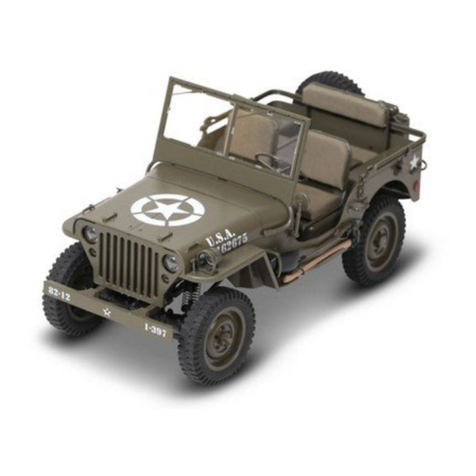
Roc Hobby
Roc Hobby DPROC001RS User manual
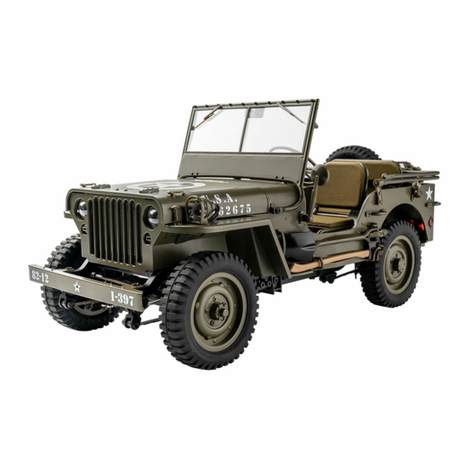
Roc Hobby
Roc Hobby SCALER MB 1941 User manual

Roc Hobby
Roc Hobby 1:10 Atlas 4x4 User manual
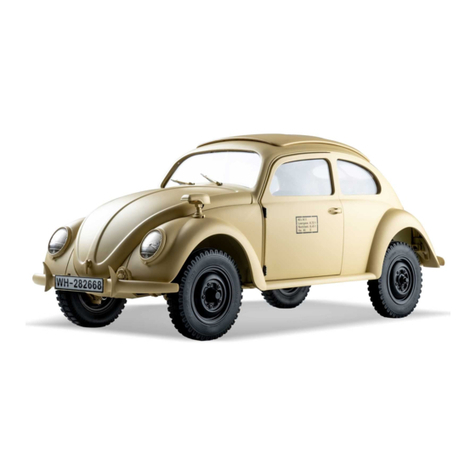
Roc Hobby
Roc Hobby 11241 User manual
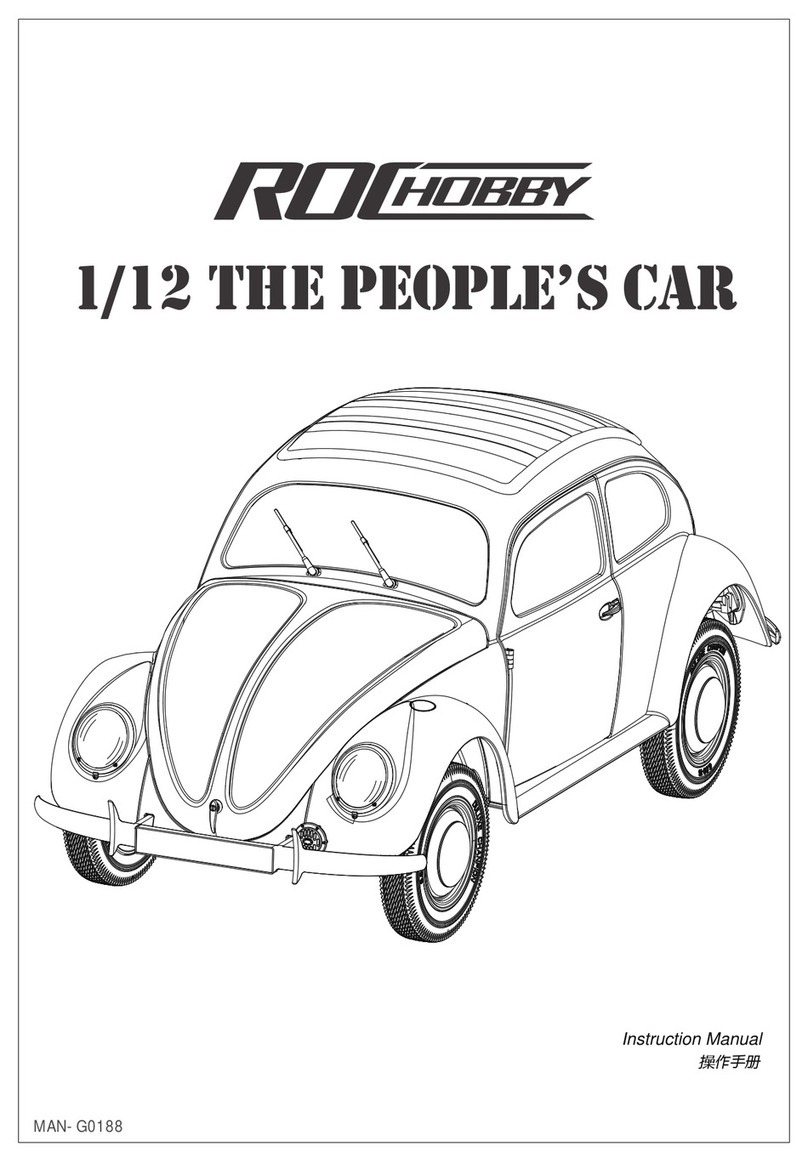
Roc Hobby
Roc Hobby ROC11242RTRCE User manual

Roc Hobby
Roc Hobby 1:18 Fire Horse User manual
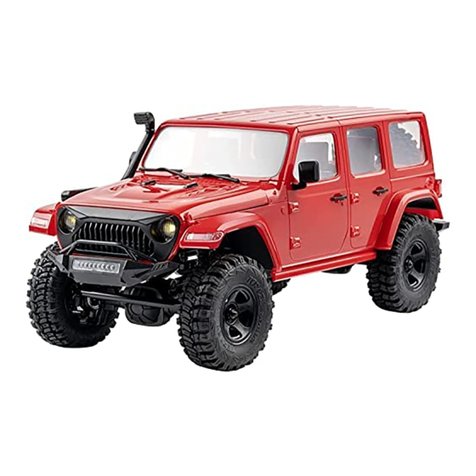
Roc Hobby
Roc Hobby 1:18 Fire Horse User manual
Popular Motorized Toy Car manuals by other brands

Pinghu City Xiao Ming Xing Children's Products
Pinghu City Xiao Ming Xing Children's Products Mercedes-Benz GLC 63 S owner's manual
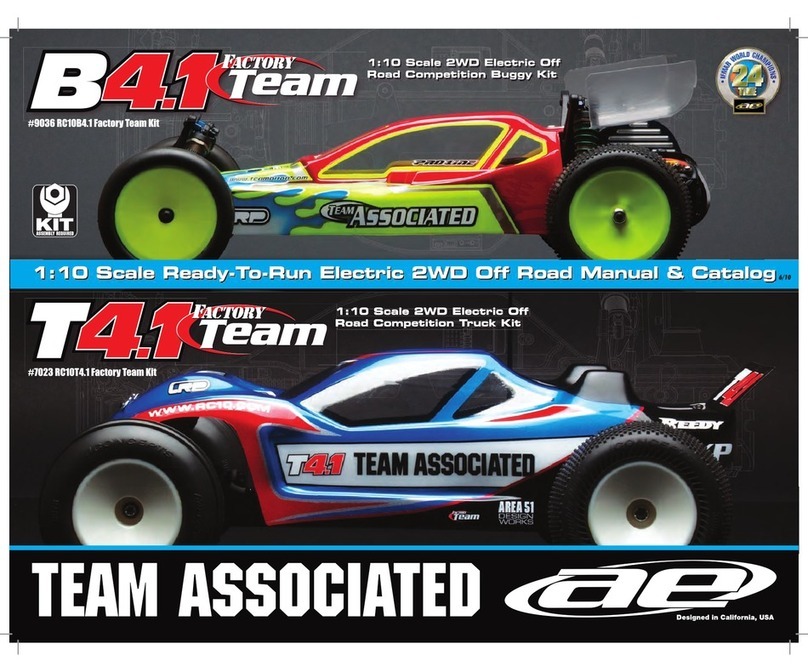
Associated Electrics
Associated Electrics T4.1 manual
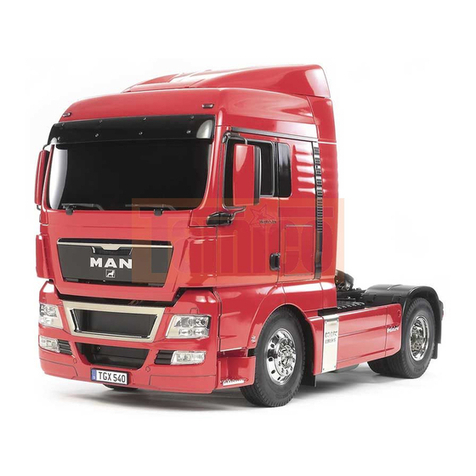
Tamiya
Tamiya MAN TGX 18.540 user manual
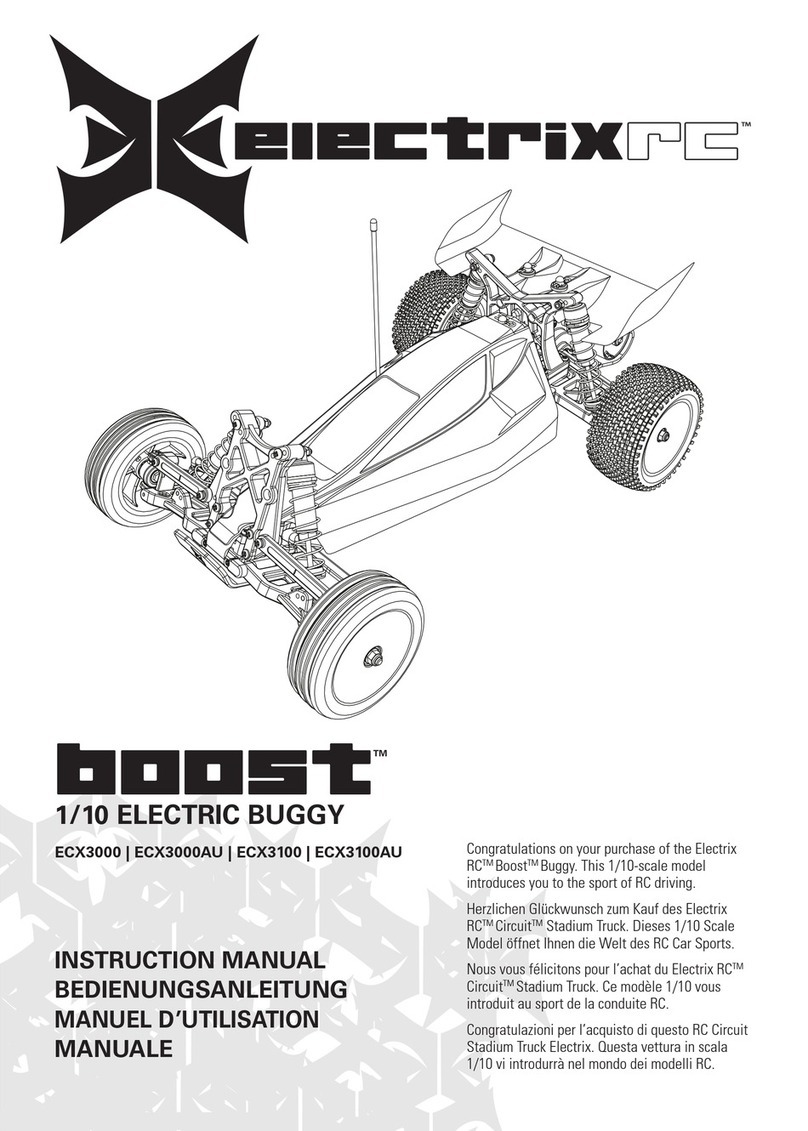
Electrix RC
Electrix RC Boost ECX3000 instruction manual
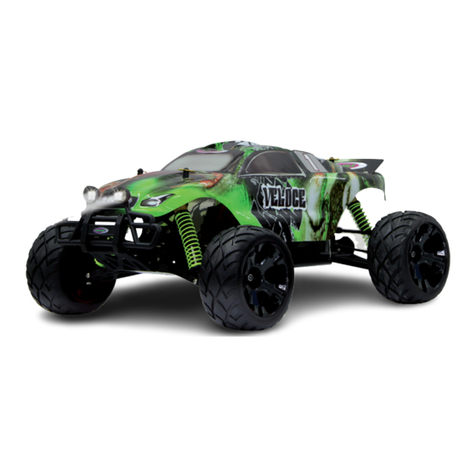
Jamara
Jamara Dakar EP 2,4 GHz Instruction
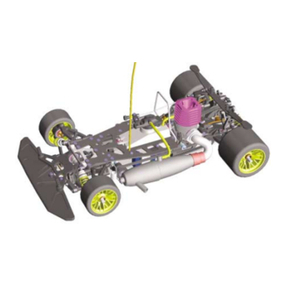
Serpent
Serpent 950 instruction manual
